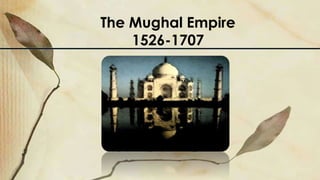
Mugal empire
- 2. Introduction Under the Mughals, India was the heart of a great Islamic empire and a prolific center of Islamic culture and learning. Dynasty was the greatest, richest and longest lasting Muslim dynasty to rule India. Mongol Descendents The Great Mughal Emperors were: ◦ Babur (1526-1530) The First of the Mughals ◦ Humayun (1530-1556) The Luckless Leader ◦ Akbar (1556-1605) The Great ◦ Jehangir (1605-1627) The Paragon of Stability ◦ Shah Jehan (1627-1658) The Master Builder ◦ Aurangzeb (1658-1707) The Intolerant
- 3. Babur 1526 - 1530 The First of the Mughals Babur was a direct descendant of the Turkish Ghengis Khan and Timur from Tamerlane. Defeated the Delhi Sultanate & established the Mughal Empire. Gained control of the whole northern India ◦ Made Agra capital He reigned for 4 short years and died at age 47 in 1530.
- 4. Humayun 1530 - 1556 The Luckless Leader After Babur died, he was succeeded by his son Humayun in 1530. Humayun was 23 years old. He was not a soldier and unlike his father, neither skilled nor a wise leader. Inherited a disunited and disorganized empire. In 1540, Sher Shah of Bengal defeated Humayun and took over the Mughal Empire. The Empire was lost from 1540-1545. ◦ He was exiled but later regained power in 1555. Humayun died in 1556 after falling down the steps of his library; he is known as “the luckless one”.
- 5. Akbar 1556 - 1605 The Great Akbar become the new Mughal ruler at the age of 14. ◦ Regent and his mother ruled in his name for 4 years Akbar was an ambitious and noble commander ◦ Built the largest army ever in the empire. ◦ Helped to conquer nearly all of modern-day northern India and Pakistan. Great administrator ◦ developed a centralized government Best known for tolerance of his subjects (especially Hindus) ◦ Removed poll taxes on Hindus Invited religious scholars to debate him in his private chambers. ◦ Developed his own faith call Din Ilahi. Din Ilahi was a mixture of the other religions Akbar had studied from those debates. Religion never caught on
- 6. Jehangir 1605 - 1627 The Paragon of Stability • Jehangir succeeded his father Akbar in 1605. • He continued many of Akbar’s policies. – Freedom of worship. – Fair treatment of Hindus. – Continued friendship and alliance with Rajputs. – Allowed foreigners like the Portuguese and English into India for trade. • Jehangir married Nur Jahan. She became the real ruler of the empire until the death of her husband.
- 7. Shah Jehan 1627 - 1658 The Master Builder • Shah Jehan succeeded his father in 1627. • Better ruler than Jehangir - Recovered territories, Maintained peace, Foreign traders were allowed into India and trade increased considerably. • Shah Jehan was a patron of the arts - Built many great architecture buildings including the Taj Mahal and the Peacock Throne, a brilliant gold throne encased in hundreds of precious gems. • Taj Mahal - Built in honor of his wife who died during childbirth, Took over a decade to build and it nearly bankrupted the empire. • Aurangzeb deposed Shah Jehan in a coup d’etat in 1658. Shah Jehan was imprisoned in the Octagonal Tower of the Agra Fort from which he could see the Taj Mahal. He died in 1666 and was buried next to his wife in the Taj Mahal.
- 8. Aurangzeb 1658 - 1707 The Intolerant Aurangzeb ascended the throne after disposing his father and beating out his two brothers. Despot ◦ severely persecuted Hindus of Northern India. Empire declines under his reign ◦ He removed the tax-free status for Hindus ◦ Destroyed their temples ◦ Crushed semi-autonomous Hindu states Primary Interest - Promote Islam vs tolerance
- 9. Aurangzeb Aurangzeb over expanded the empire and strained his resources. ◦ Large sums of money and manpower were lost. ◦ He lost the support of the Hindu people. ◦ The over expansion of his empire weakened his administration. Built Bibi la Maqbara, which is very similar in architectural style to Taj Mahal. Aurangzeb’s other architectural legacy included: • Moti Masjid (Delhi Fort), Delhi (1659) • Buri-I-Shamali (Delhi Fort), Delhi • Badshahi Mosque, Lahore (1674) Aurangzeb died in 1707 His son Bahadur Shah succeeded him. Bahadur was so old by the time he ascended the throne, he only managed to live a few more years. But at this point in time, the government was so unstable and so weak, the empire become an easy target of invasion and exploitation, first by the Persians, and then by the British. • The death of Aurangzeb and the short reign of his son led to the end of the Mughal empire and the beginning of British Rule.
- 10. The Success of the Mughals It is agreed among many scholars that the Mughal empire was the greatest, richest and most long-lasting Muslim dynasty to rule India. This period of Mughal rule produced the finest and most elegant art and architecture in the history of Muslim dynasties. The Mughal emperors, with few exceptions, were among the world’s most aesthetically minded rules. Although Turkish and Persian in background, the Mughals were not Muslim rulers of India but Indian rulers who happened to be Muslims. This idea is most evident in Akbar’s obsession of a utopian India for Hindus and Muslims. The longevity of the Mughal empire can be contributed to a number of factors. The Mughal emperors were ambitious and for the most part able rulers. But Akbar is perhaps the Mughal emperor responsible for much of the prosperity and harmony achieved during the Mughal Empire. The Mughal Empire and the Great Mughals will always be remembered as a great influence on the artistic and cultural life of India. Their architectural style can still be seen today such as the Taj Mahal built by Shah Jehan and the buildings at Fatehpur Sikri.